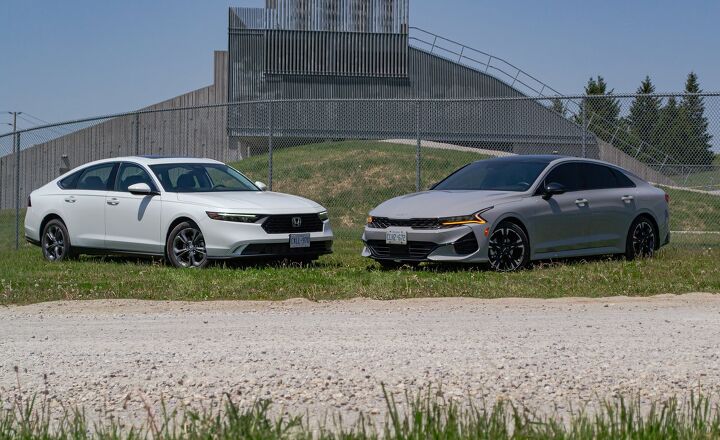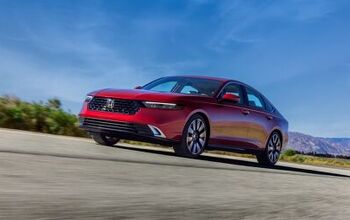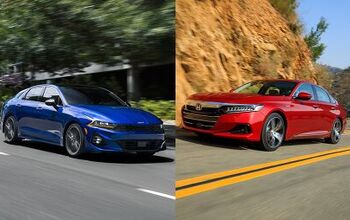Honda Accord Vs Kia K5 Comparison

This four-door face-off boils down to two things: reputation, or value.
The Honda Accord needs no introduction. Now in its 11th generation, Honda’s mid-sized sedan has won countless awards, sold in the millions, and remains one of the best-selling cars in Canada and the US. This generation debuted late last year, sticking to roughly the same size as what came before, but draping it all in new styling. There are big changes under the skin, too: a revised hybrid powertrain bumps off the 2.0-liter turbo-four as the premium engine choice. That means that the Accord EX we have here is, at least currently, the highest-trim non-hybrid model you can buy.
Admit it, you kind of forgot about the Kia K5. It’s okay: going by the sales (66,298 in the US in 2022), so did a lot of the market. It sold less than half what the Accord did (154,612), which itself only just scraped by a little over 50-percent of what the juggernaut Toyota Camry managed. While we can quibble over Kia ditching the Optima name in 2021, we can’t argue with the stupendous value proposition the stylish K5 has, here in GT-Line AWD form.
For those still looking at sedans in this SUV-crazed world, both of these present strong arguments. Managing editor Mike Schlee and I spent a week with both to figure out which is the right pick.
Get a Quote on a New Honda Accord or Kia K5Interior and Cargo Space
Honda Accord: Like a vehicular Colin Quinn, Honda’s interior design team has found its story and is sticking to it. The current style debuted in the Civic, and it translates well to the larger Accord. A simple dashboard design keeps the cowl nice and low, and a mesh strip running the entire width cleverly hides the air vents. Peep below and Honda has centralized the climate controls, complete with a trio of nicely-textured, satisfyingly clicky rotary dials. The center console has a good amount of storage space, and keeps the tandem cupholders to the right of the shifter—the best approach.
It’s a clean, confident design overall. Unfortunately, there just isn’t much variation in terms of materials. It’s a lot of black plastic, which is a letdown after the K5.
The cloth seats at least have some melange to them. They’re very comfortable, and in that typical Honda way, are bolted in nice and low for not just a better driving position, but far more headroom. More actual headroom, anyway: on paper, the Accord’s 37.5 inches (953 millimeters) is about an inch shy of the K5’s 38.4 inches (975 mm).
The cloth seats at least have some melange to them. They’re very comfortable, and in that typical Honda way, are bolted in nice and low for not just a better driving position, but far more headroom. More actual headroom, anyway: on paper, the Accord’s 37.5 inches (953 millimeters) is about an inch shy of the K5’s 38.4 inches (975 mm).
There’s more good news in the back row, where the Accord is the more spacious of this pair. These two are basically the same in terms of airspace, offering just a sliver less headroom than the front. But the Accord has noticeably more legroom, both officially (40.8 inches / 1,036 mm) and in practice. It also has a flatter shoulder line, with more side glass. That almost makes up for the tiny sunroof.
The Accord inches ahead of the K5 in the trunk space race, too. Literally: it offers 16.7 cubic feet (473 liters) of trunk space, less than five percent more than the Kia.
Kia K5: Schlee doesn’t mince words. “Interior is gorgeous,” he notes. “Love the expose wood. All the controls and materials work well together. Feels premium and better than a family sedan.” While the Kia’s dashboard isn’t any chunkier than the Accord’s thinline example, it features a more visually interesting design with a variety of textures and materials. The climate controls are all grouped down low within reach, though the seat temperature controls are on an island elsewhere on the center console. The transmission tunnel also houses one of our absolute favorite wireless chargers: a mailbox-like slot that keeps the phone firmly in place, and out of view.
The wraparound design gives the K5 a more intimate, cockpit-like feel. So does the high seating position, which has both of us fumbling with the power adjustments to keep hair and headliner separate. It’s too bad, as the synthetic leather seating is otherwise super supportive—and who doesn’t love ventilation in summer?
The second row is an alright space to be, too. It’s adult-friendly thanks to nicely sculpted seats, though it does have noticeably less legroom than the lounge-like Accord. Natural light is a bit of a wash: the K5’s window line is tighter, but the pano roof balances that out.
Trunk space is an even 16.0 cubic feet; slightly less than the Accord, but still larger than pretty much any other three-box sedan out there.
Bottom Line: The Accord has more space, but the K5 has more grace. The Kia has the classier cabin, and it’s full of smart storage solutions, too. It wins the first category.
Honda Accord vs Kia K5: Tech and Features
Accord: For years, the perpetual infotainment fall guys have been Lexus (and the nearly exorcised touchpad), Acura (also pad-proud) and Mazda (for its lack of touch controls). But somehow, Honda’s base system has flown under the radar. Simply put, it’s one of the most bare-bones, out-of-date setups on the market—and certainly so at this price point.
What you see above is the main menu. When using the radio, it’s a mostly black screen with basic info. My old Blackberry had prettier menus. And we haven’t even talked about the huge bezel surrounding this itty-bitty 7.0-inch screen. Plug your phone in for Apple CarPlay or Android Auto and just stick to that. At least the Accord’s digital instrument panel is both good-looking and functional. It’ll even route directions through an iPhone’s Apple Maps, which is handy.
The rest of the Accord’s tech suite is similarly bare. The Honda Sensing lineup of driver assists is standard across the board, so that’s good, and this tester includes the blind-spot monitoring with rear cross-traffic alert. But it misses out on features like navigation, wireless charging, HD radio, and rear USB ports.
K5: The K5 was one of the first modern Kias to debut the 10.25-inch touchscreen infotainment. It’s a pretty useful system, and miles ahead of the Accord’s primitive setup. Our criticisms are minor: the cool color scheme and typeface make it hard to navigate at a glance, and the capacitive buttons on the bezel can be hard to reach. But it gives you plenty of features, including navigation. The leash for smartphones isn’t even a problem, and at least back-row occupants get USB charging ports, too.
About the only thing the K5 lags behind the Accord on is its analog dials. The central screen is fine enough, and still gets the necessary info to you. It has a wireless charger, heated and ventilated front seats, and its six-speaker sound system is no worse than the Accord’s eight.
The Kia has the advantage on the safety front, too. The Drive Wise lineup matches the Accord on all fronts (automated emergency braking, lane-keep assist, auto high beams, adaptive cruise control with stop and go, driver attention warning), but goes further with Kia’s Highway Drive Assist, Lead Car Notification, and Safe Exit Assist.
Bottom Line: Another notch for the Kia, which comes with so much more standard kit.
Powertrain, Driving Feel, and Efficiency
Accord: Despite having a slight displacement disadvantage, the Accord has the edge in power here. The 1.5-liter turbocharged engine puts down a “square” 192 horsepower and 192 pound-feet of torque. It sends that power through a continuously variable transmission, to what is increasingly rare in this segment: just the front wheels.
That might sound like a far cry from the 2.0-liter, six-speed manual offered in the last generation. But the Accord excels at smooth, calm progress. The ample torque keeps the CVT operating low in the rev range, and the lack of noticeable cog swaps does feel—whisper it—kind of luxurious.
The Accord’s suspension is expertly judged. Compliant without feeling wallowy, it too feels made for the premium segment. The steering is light yet sharp and consistent.
Fuel economy is another Accord strength. Unencumbered with an extra powered axle, the Honda is capable of 29 mpg city and 37 mpg highway, for a combined 32 mpg rating. Canadian equivalents are 8.1, 6.4, and 7.3 L/100 km, respectively.
K5: Every K5 except the GT runs the ubiquitous Hyundai Motor Group 1.6-liter turbo-four. Here it funnels its 180 hp and 195 lb-ft through an eight-speed auto to all the wheels.
Folks in cooler climates will like that all-paw grip, but it does limit the K5’s abilities here in summer. Nevermind the gruff engine note; the K5 just doesn’t feel as eager to shift as the Accord, needing decent revs to really make its power. The eight-speed is fine, but can occasionally be sluggish to respond in on-and-off situations. Both Schlee and I never thought we’d prefer a CVT over a traditional slushbox, but here we are.
The K5’s ride is more of the same: good, but not as finely tuned as the Accord’s. The K5 feels heavier, more deliberate in its movements. The steering is similarly feel-free, but there’s some initial gloopiness off-center that the Accord’s tiller lacks. We know Kia can make this platform fun, as the rough-and-tumble K5 GT proves, but the GT-Line never encourages us to take the long way home.
The AWD also saddles the Kia with poorer fuel economy. Its combined figure (28 mpg) is worse than the Accord’s city rating, and over the week, it couldn’t match that, while the Accord comfortably bettered its official figure. City and highway numbers are 25 and 33 mpg (9.4 and 7.1 L/100 km), respectively.
Bottom Line: This is the Accord’s category, no doubt about it. Its engine, transmission, and suspension are all better. It has better fuel economy too, even if we had the front-drive K5 here.
Honda Accord vs Kia K5: Styling
Accord: Both Schlee and I generally like the Accord well enough. The styling is clean and conservative—again, a direction Honda first headed with the latest Civic. We do like the full-width taillight treatment, too. The wheelbase is the same as the last generation, but overall length is up, which can give the Accord a bit of a long-nose look in profile. On the flip-side, those little 17-inch alloy wheels are drowning under all that white sheetmetal.
K5: The K5 remains one of our favorite mainstream sedans, maybe because of how rare it is. The low nose, the funky “heartbeat” DRLs—now the last amber ones at Kia—the swooping profile. Who doesn’t love those two-tone, 18-inch alloys, either, or the detailed taillight design? Mike calls it attractive, but notes some of the fussier bits around back. “Rear has a few trickery bits,” he explains, “like the fake exhaust tips, fake vents, and black piece on the trunk that continues the rear window to appear like a fastback like the Stinger.”
Bottom Line: The new Accord can look pretty slick, but it needs the larger wheels to do that, and they’re only available on the hybrid. The K5 might not age as well, but we think it still looks excellent.
Pricing and Value
Accord: As tested, this Accord EX rings in at $31,160 ($39,130 CAD). It is the top non-hybrid trim, and the only extra-cost option beyond premium paint is the blind spot and cross-traffic combo. We feel it’s important to note the most affordable hybrid (the Sport) isn’t too much more and in addition to 50-percent better fuel economy, it has a better infotainment system and no less features (well, heated seats in the US).
K5: How much do all the extra goodies run K5 buyers? Uh, just $31,760 as-tested in the US, including destination; a mere $600 more than the Accord. In Canada, it’s even closer: this tester is $39,295 CAD, a difference of just $165 CAD. In America, you could even go for the front-drive model and pocket the savings; in Canada, the GT-Line is AWD-only.
Bottom Line: No doubt about it, at such level pricing, the K5 is the clear winner here.
Honda Accord vs Kia K5: Verdict
After the week was over, we were left puzzled by this latest Accord. No doubt about it: in hybrid form, it’s an excellent sedan. We got to experience just that only two weeks later. But earlier generations never required you to move to the upgrade engine to enjoy Honda’s headline family sedan. The Accord EX just so pricey for what it offers. The drivetrain is excellent, but the rest of the sedan feels decontented, to intentionally funnel buyers towards higher-margin trims.
The K5 is such a good value play—not to mention stylish—that we can’t ignore its appeal. Who knows; maybe a rematch with the Accord Sport Touring would’ve justified the big H’s extra cost with even more refinement and a better interior experience. But as-tested, in these two forms, both Schlee and I would go with the sales underdog here.
Become an AutoGuide insider. Get the latest from the automotive world first by subscribing to our newsletter here.

Kyle began his automotive obsession before he even started school, courtesy of a remote control Porsche and various LEGO sets. He later studied advertising and graphic design at Humber College, which led him to writing about cars (both real and digital). He is now a proud member of the Automobile Journalists Association of Canada (AJAC), where he was the Journalist of the Year runner-up for 2021.
More by Kyle Patrick

















































Comments
Join the conversation
Neglected to mention manufacturers warranty. KIA has a 5 year 60,000 mile base warranty and 10 year 100,000 mile power train warranty. Hard to beat that.
Overall, good reporting on both vehicles.